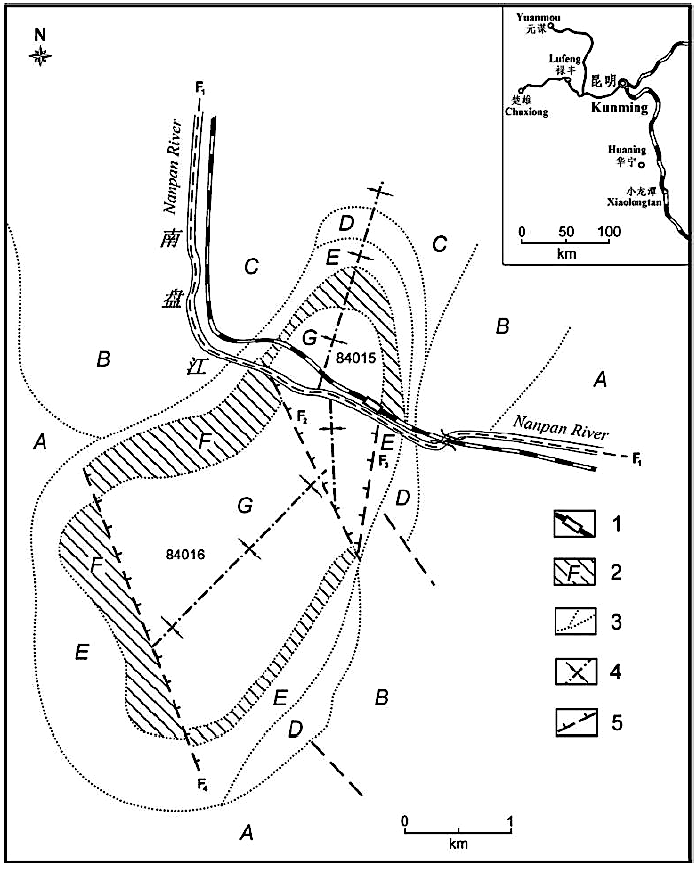Xiaolongtan Fm
Type Locality and Naming
[Figure: Geological map of Xiaolongtan Basin: (1) Xiaolongtan railway station; (2) hominoid horizon; (3) stratigraphic boundary; (4) axis of syncline; (5) fault; (A) Gejiu Formation; (B) Falang Fm; (C) Huobachong Fm; (D) Dongshenqiao Fm; (E) Xiaolongtan Fm; (F) hominoid horizon; (G) Buzhaoba Fm Marlite; 84015 = Xiaolongtan Pit; 84016 = Buzhaoba Pit (modified by Dong and Qi, 2013).]
Lithology and Thickness
Mainly gray or grayish white conglomerate, sandstone, claystone and marlstone with lignite. The formation is divided in into three parts: the lower part, the conglomerate member; the middle part, the lignite-claystone member; and the upper part is the marlstone member. The thickness highly varies 104-1070 m, with the thickest 2139 m.
Relationships and Distribution
Lower contact
This formation is unconformably overlying on the different older strata, such as Middle Triassic Gejiu Fm or Paleogene Caijiachong Fm (column 20a). [also shown on regional lithology graphic columns is a next older regional unit of Eocene-age Xiaotan Fm]
Upper contact
This formation is unconformably underlain (overlain?) by the Ciying Fm.
Regional extent
It is distributed in the Xiaolongtan basin, Kaiyuan County, as well as Mengzi County, Jianshui County and Huaning County, Yunnan. The lignite bed therein is one of the important coal horizons in Yunnan Province.
[Figure: Coalfield of Xiaolongtan, Kaiyuan, Yunnan (by courtesy of Ji Xueping).]
GeoJSON
Fossils
This formation contains rich mammals and plants, and famous for its discovery of Dryopithecus kaiyuanensis. At least eleven species of fossil mammals have been recorded, being mainly Sivapithecus sp. (=Dryopithecus keiyuanensis), Tapirus cf. yunnanensis, Propotamochoerus parvulus, Dicoryphochoerus sp., Listriodon sp., Tetralophodon xiaolongtanensis, Gomphotherium cf. macrognathus and Zygologphodon chinjiensis. The fossil plants total 8 families and 16 genera, of which more than 50% are living species, e.g. Pterocarya huaxiensis, Laurus, Albizzia, Dalberyia and Sophora, reflecting that this area was in a tropical forest environment.
[Figure: Teeth of Dryopithecus kaiyuanensis from the coal bed of Xiaolongtan, Kaiyuan, Yunnan (Wu, 1958).
Age
Depositional setting
Additional Information


